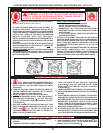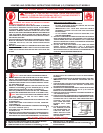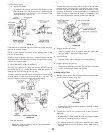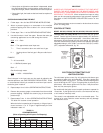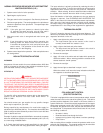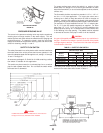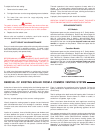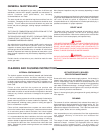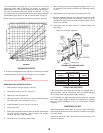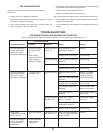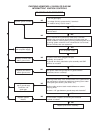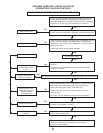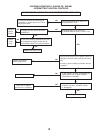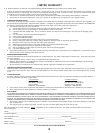
5555
5555
55
GENERAL MAINTENANCE
These boilers are designed to give many years of efficient and
satisfactory service when properly operated and maintained. To
assure continued good performance, the following
recommendations are made.
The area around the unit should be kept clean and free from lint
and debris. Sweeping the floor around the boiler should be done
carefully. This will reduce the dust and dirt which may enter the
burner and pilot air passages, causing improper combustion and
sooting.
THE FLOW OF COMBUSTION AND VENTILATION AIR TO THE
BOILER MUST NOT BE OBSTRUCTED.
THE BOILER AREA MUST BE KEPT CLEAR AND FREE FROM
COMBUSTIBLE MATERIALS, GASOLINE, AND OTHER
FLAMMABLE VAPORS AND LIQUIDS.
Any safety devices including low water cutoffs used in conjunction
with this boiler should receive periodic (every six months)
inspection to assure proper operation. A low water cutoff device of
the float type should be flushed every six months. All relief valves
should be inspected and manually operated at least twice a year.
More frequent inspections may be necessary depending on water
conditions.
Periodic checks, at least twice a year, should be made for water
and/or gas leaks.
More frequent inspections may be necessary depending on water
conditions.
The boiler mounted gas and electrical controls have been designed
to give both dependable service and long life. However, malfunction
can occur, as with any piece of equipment. It is therefore
recommended that all components be checked periodically by a
qualified serviceman for proper operation.
RELIEF VALVE
The safety relief valve should be opened at least twice a year to
check its working condition. This will aid in assuring proper
pressure relief protection. Lift the lever at the top of the valve several
times until the valve seats properly and operate freely.
DANGER
THE WATER PASSING OUT OF THE VALVE DURING CHECKING
OPERATION MAY BE EXTREMELY HOT. BEFORE OPERATING
RELIEF VALVE MAKE SURE DRAIN LINE IS INSTALLED TO
DIRECT DISCHARGE TO A SAFE LOCATION SUCH AS AN OPEN
DRAIN, TO AVOID SCALDING OR WATER DAMAGE.
WARNING
SHOULD OVERHEATING OCCUR OR THE GAS SUPPLY FAIL TO
SHUT OFF, TURN THE MANUAL GAS CONTROL VALVE TO THE
APPLIANCE.
INTERNAL CONTAMINANTS
The hydronic system must be internally cleaned and flushed after
a new or replacement boiler has been installed to remove
contaminants that may have accumulated during installation. This
is doubly important when a replacement boiler is installed into an
existing system where Stop Leak or other boiler additives have
been used.
Failure to clean and flush the system can produce acid
concentrations that become corrosive, cause gases to form that
block water circulation or lead to formation of deposits on the boiler
surfaces, any of which could result in damage to the system and
circulator.
All hot water heating systems should be completely flushed with a
grease removing solution to assure trouble-tree operation. Pipe
joint compounds, soldering paste, grease on tubing and pipe all
tend to contaminate a system.
Failure to flush contaminates from a system can cause solids to
form on the inside of boiler exchangers, create excessive amounts
of air and other gases to block circulation, foul various system
accessories and even deteriorate circulation seals and impellers.
It is recommended that after installation, the boiler and system
when filled should include the proper percentage of cleaning
solution related to approximate water volume of the system. Fire
and circulate for about one hour and then flush clean with fresh
water. Commercial grease removing solutions are available from
your distributor.
CLEANING AND FLUSHING INSTRUCTIONS
HOT WATER SUPPLY BOILERS
PREVENTIVE MAINTENANCE
Some solids exist in most water supply systems. As the water is
heated, these tend to drop out depositing as scale or lime. This
scale is comparatively easy to remove if cleaned before the unit
becomes clogged. The time between cleaning will vary depending
upon water conditions and usage. A change of about 5
0
F (3°C) in
the normal temperature rise through the unit is usually an indication
that it is time for preventive maintenance.
Figure 31 shows typical piping arrangement for gravity deliming of
lime deposits.
DELIMING
The amount of calcium carbonate (lime) released from water is in
direct proportion to water temperature and usage, see fig. 49. The
higher the water temperature or water usage, the more lime
deposits are dropped out of the water. This is the lime scale which
forms in pipes, boilers and on cooking utensils.
Lime accumulation not only reduces the life of the equipment but
also reduces efficiency of the boiler and increases fuel
consumption.
The usage of water softening equipment greatly reduces the
hardness of water. However, this equipment does not always
remove all of the hardness (lime). For this reason it is
recommended that a regular schedule for deliming be maintained.



